Free Vibrations of Sandwich Plates with Damaged Soft-Core and Non-Uniform Mechanical Properties: Modeling and Finite Element Analysis
Abstract
:1. Introduction
2. Geometric and Mechanical Characterization
2.1. Mechanical Properties of the Face-Sheets
2.2. Mechanical Properties of the Damaged Matrix
3. Finite Element Model Based on A First-Order Zig-Zag Plate Theory
3.1. Numerical Computation of the Fundamental Matrices
3.2. Evaluation of the Natural Frequencies
4. Numerical Applications
4.1. Influence of the Murakami’s Function and Validation of the RMZ
- The RMZ theory provides natural frequencies that are close to the results given by the reference solution (3D-FE). In fact, the maximum percentage difference is about 5% for higher modes. This difference is satisfactory having in mind the approximation introduced by a two-dimensional ESL theory;
- The computational cost is very different. In particular, the number of degrees of freedom in the 3D-FE model is ten times the one needed by the RMZ theory to obtain similar values;
- The RM model is not adequate to evaluate the natural frequencies of a sandwich soft-core structure, as it can be observed by the percentage differences with respect to the reference solution. The number of degrees of freedom in this circumstance is even lower if compared to the other models, but the computational saving cannot justify the poor approximation of the solution.
4.2. Validation of the Model with Respect to Non-Uniform Distributions of the Reinforcing Fibers
4.3. Effect of Damage
- The decrease of the frequency is clearly caused by the corresponding stiffness reduction of the structures. This expected tendency models accurately the physical behavior of structures with a lower value of stiffness. In fact, by increasing the value of up to the unity (fully damaged core), the frequency would tend to zero;
- The same behavior is obtained for each volume fraction distribution, but the maximum value of the first frequency that can be reached depends on the through-the-thickness distributions of (Figure 5);
- These aspects can be noted for each lamination scheme. Nevertheless, depending on the in-plane fiber orientation, the value of the first frequency could change. In addition, a peculiar choice of lamination scheme could reduce the influence of the through-the-thickness distributions of the volume fraction , since the curves related to the various schemes are less detached;
- Finally, similar graphs could be obtained also for higher frequencies.
4.4. Influence of the Exponent of the Through-the-Thickness Distribution of the Fiber Volume Fraction
- Similar behaviors are obtained for the three lamination schemes under investigation. For lower values of , the corresponding curves are detached and the natural frequencies that can be obtained assume different values depending on the fiber orientation. By increasing the exponent , the effect of the fibers decreases since draws near zero and the frequencies tends asymptotically to the same value;
- The initial choice of the through-the-thickness distribution of (Scheme 2 or Scheme 3) affects the variation of the natural frequencies. In particular, this variation is faster for Scheme 2. In fact, the slopes of the related curves are steeper, whereas the frequency variation for Scheme 3 is a little bit more gradual;
- The biggest variation of frequencies is reached for lower values of . The decrease of the value of natural frequencies for is negligible.
4.5. Effect of the In-Plane Fiber Orientation
- As expected, the orientation of the fibers affects the dynamic response of the composite structures under consideration;
- If symmetric angle-ply or cross-ply laminates, as well as antisymmetric configurations, are considered, which are denoted by (/core/) and (−/core/), the extreme values of frequencies can be obtained for . In addition, a symmetrical behavior is obtained after reaching the value of ;
- This regular and symmetric behavior is lost if a laminate with a general stacking sequence, such as the last two lamination schemes, is analyzed.
4.6. Influence of the Material Properties
- The influence of the CNT mass fraction is greater than the corresponding variation of the fiber mass fraction ;
- For a small increase of next to zero, the variation in terms of natural frequencies that can be obtained is relevant and the behavior is non-linear;
- On the other hand, bigger increases of do not produce the same variation of natural frequencies. The behavior is linear in this case.
4.7. Discussion on the Mode Shapes
- In general, the increase of the damage parameter does not cause any variation of the mode shapes;
- The mode shapes are highly affected by the orientation of the reinforcing fibers and by the stacking sequence. This aspect can be noted by comparing the same configurations in terms of and , but characterized by different lamination schemes (Case 1 and Case 4, for instance);
- As stated in the previous paragraphs, the increase of the exponent reduces the influence of the reinforcing straight fibers. Therefore, the anisotropic behavior of a laminate with a general stacking sequence can be decreased. For example, the mode shapes of Case 7 tend to the ones related to Case 3 for , even if they are characterized by different fiber orientations;
- The presence of a thicker isotropic core is predominant in the modal amplitudes and only noticeably variations of these mechanical parameters can define some changes in the mode shapes.
5. Conclusions
- The use of the Murakami’s function is required to capture the effective mechanical behavior of sandwich structures with an inner soft-core. This aspect is very important especially if a FE commercial code is employed. In fact, it should be recalled that this function is not embedded in plate/shell formulations. Therefore, the results that can be obtained in these circumstances could be inaccurate, unless a 3D-FE modelling is pursued. Nevertheless, this approach is onerous in terms of computational time and resources;
- A non-uniform distribution of the fibers along the thickness of the face-sheets could be employed to model the effective distribution of the reinforcing phase that could occur during the manufacturing process or during the structural life. This research prove that the mechanical response is affected by this parameter;
- A progressive damage in the core causes a corresponding decrease of the natural frequencies, which becomes faster and faster for higher values of damages. The reinforcing layers could recover this situation. If a three-phase composite material is employed to this aim, the design of such layers could be carried out taking into account two parameters, which are the mass fractions of both CNTs and fibers. Nevertheless, a small increase of the CNT mass fraction can cause a quicker and more remarkable variation of the fundamental frequency with respect to the one that could be obtained by controlling the mass fraction of the straight fibers;
- The optimal structural response can be also obtained by choosing accurately the in-plane orientation of the straight fibers. The stacking sequence, in fact, affects the value of the natural frequencies, as well as of the mode shapes.
Author Contributions
Funding
Conflicts of Interest
Appendix A
References
- Duncan, W.J.; Collar, A.R. A method for the solution of oscillations problems by matrices. Phil. Mag. 1934, 17, 865–909. [Google Scholar] [CrossRef]
- Duncan, W.J.; Collar, A.R. Matrices applied to the motions of damped systems. Phil. Mag. 1935, 19, 197–219. [Google Scholar] [CrossRef]
- Hrennikoff, A. Solution of Problems of Elasticity by the Frame–Work Method. ASME J. Appl. Mech. 1941, 8, A619–A715. [Google Scholar]
- Courant, R. Variational methods for the solution of problems of equilibrium and vibration. B. Am. Math. Soc. 1943, 49, 1–23. [Google Scholar] [CrossRef]
- Clough, R.W. The finite element method in plane stress analysis. In Proceedings of the 2nd ASCE conference in electronics computation, Pittsburgh, PA, USA, 8–9 September 1960. [Google Scholar]
- Melosh, R.J. Basis for derivation of matrices for the direct stiffness method. AIAA J. 1963, 1, 1631–1637. [Google Scholar] [CrossRef]
- Oden, J.T. Finite Elements of Nonlinear Continua; McGraw-Hill: New York, NY, USA, 1972. [Google Scholar]
- Oden, J.T.; Reddy, J.N. An Introduction to the Mathematical Theory of Finite Elements; John Wiley: New York, NY, USA, 1976. [Google Scholar]
- Hinton, E. Numerical Methods and Software for Dynamic Analysis of Plates and Shells; Pineridge Press: Swansea, UK, 1988. [Google Scholar]
- Zienkiewicz, O.C. The Finite Element Method; McGraw–Hill: New York, NY, USA, 1991. [Google Scholar]
- Reddy, J.N. An Introduction to the Finite Element Method; McGraw–Hill: New York, NY, USA, 1993. [Google Scholar]
- Hughes, T.J.R. The Finite Element Method-Linear Static and Dynamic Finite Element Analysis; Dover Publications: New York, NY, USA, 2000. [Google Scholar]
- Ferreira, A.J.M. MATLAB Codes for Finite Element Analysis; Springer: New York, NY, USA, 2008. [Google Scholar]
- Martínez-Pañeda, E. On the finite element implementation of functionally graded materials. Materials 2019, 12, 287. [Google Scholar] [CrossRef]
- Nguyen, H.N.; Nguyen, T.Y.; Tran, K.V.; Tran, T.T.; Nguyen, T.T.; Phan, V.D.; Do, T.V. A finite element model for dynamic analysis of triple-layer composite plates with layers connected by shear connectors subjected to moving load. Materials 2019, 12, 598. [Google Scholar] [CrossRef] [PubMed]
- Leonetti, L.; Fantuzzi, N.; Trovalusci, P.; Tornabene, F. Scale effects in orthotropic composite assemblies as micropolar continua: A comparison between weak-and strong-form finite element solutions. Materials 2019, 12, 758. [Google Scholar] [CrossRef]
- Liu, P.; Bui, T.Q.; Zhu, D.; Yu, T.T.; Wang, J.W.; Yin, S.H.; Hirose, S. Buckling failure analysis of cracked functionally graded plates by a stabilized discrete shear gap extended 3-node triangular plate element. Compos. Part B Eng. 2015, 77, 179–193. [Google Scholar] [CrossRef]
- Hosseini, S.S.; Bayesteh, H.; Mohammadi, S. Thermo-mechanical XFEM crack propagation analysis of functionally graded materials. Mat. Sci. Eng. A 2013, 561, 285–302. [Google Scholar] [CrossRef]
- Yin, S.; Yu, T.; Bui, T.Q.; Liu, P.; Hirose, S. Buckling and vibration extended isogeometric analysis of imperfect graded Reissner-Mindlin plates with internal defects using NURBS and level sets. Comput. Struct. 2016, 177, 23–38. [Google Scholar] [CrossRef]
- Singh, S.K.; Singh, I.V.; Mishra, B.K.; Bhardwaj, G.; Singh, S.K. Analysis of cracked plate using higher-order shear deformation theory: Asymptotic crack-tip fields and XIGA implementation. Comput. Method. Appl. M. 2018, 336, 594–639. [Google Scholar] [CrossRef]
- Lemaitre, J.; Chaboche, J.L. Mechanics of Solid Materials; Cambridge University Press: New York, NY, USA, 1990. [Google Scholar]
- Reddy, J.N.; Miravete, A. Practical Analysis of Composite Laminates; CRC Press: Boca Raton, FL, USA, 1995. [Google Scholar]
- Tarantino, A.M. Equilibrium paths of a hyperelastic body under progressive damage. J. Elast. 2014, 114, 225–250. [Google Scholar] [CrossRef]
- Lanzoni, L.; Tarantino, A.M. Damaged hyperelastic membranes. Int. J. Nonlinear Mech. 2014, 60, 9–22. [Google Scholar] [CrossRef]
- Lanzoni, L.; Tarantino, A.M. Equilibrium configurations and stability of a damaged body under uniaxial tractions. Z. Angew. Math. Phys. 2015, 66, 171–190. [Google Scholar] [CrossRef]
- Lanzoni, L.; Tarantino, A.M. A simple nonlinear model to simulate the localized necking and neck propagation. Int. J. Nonlinear Mech. 2016, 84, 94–104. [Google Scholar] [CrossRef]
- Savino, V.; Lanzoni, L.; Tarantino, A.M.; Viviani, M. Simple and effective models to predict the compressive and tensile strength of HPFRC as the steel fiber content and type changes. Compos. Part B Eng. 2018, 137, 153–162. [Google Scholar] [CrossRef] [Green Version]
- Falope, F.O.; Lanzoni, L.; Tarantino, A.M. Modified hinged beam test on steel fabric reinforced cementitious matrix (SFRCM). Compos. Part B Eng. 2018, 146, 232–243. [Google Scholar] [CrossRef]
- Dezi, L.; Menditto, G.; Tarantino, A.M. Homogeneous structures subjected to successive structural system changes. J. Eng. Mech. ASCE 1990, 116, 1723–1732. [Google Scholar] [CrossRef]
- Dezi, L.; Tarantino, A.M. Time dependent analysis of concrete structures with variable structural system. ACI Mater. J. 1991, 88, 320–324. [Google Scholar]
- Dezi, L.; Menditto, G.; Tarantino, A.M. Viscoelastic heterogeneous structures with variable structural system. J. Eng. Mech. ASCE 1992, 119, 238–250. [Google Scholar] [CrossRef]
- Dezi, L.; Tarantino, A.M. Creep in continuous composite beams. Part II: Parametric study. J. Eng. Mech. ASCE 1993, 119, 2112–2133. [Google Scholar]
- Tarantino, A.M. Homogeneous equilibrium configurations of a hyperelastic compressible cube under equitriaxial dead-load tractions. J. Elast. 2008, 92, 227–254. [Google Scholar] [CrossRef]
- Vinson, J.R. The Behavior of Shells Composed of Isotropic and Composite Materials; Springer: New York, NY, USA, 1993. [Google Scholar]
- Jones, R.M. Mechanics of Composite Materials, 2nd ed.; Taylor & Francis: Philadelphia, PA, USA, 1999. [Google Scholar]
- Reddy, J.N. Mechanics of Laminated Composite Plates and Shells-Theory and Analysis, 2nd ed.; CRC Press: Boca Raton, FL, USA, 2004. [Google Scholar]
- Barbero, E.J. Introduction to Composite Materials Design; CRC Press: Boca Raton, FL, USA, 2011. [Google Scholar]
- Tornabene, F.; Bacciocchi, M.; Fantuzzi, N.; Reddy, J.N. Multiscale approach for three-phase cnt/polymer/ fiber laminated nanocomposite structures. Polym. Compos. 2019, 40, E102–E126. [Google Scholar] [CrossRef]
- Bacciocchi, M.; Tarantino, A.M. Time-dependent behavior of viscoelastic three-phase composite plates reinforced by carbon nanotubes. Compos. Struct. 2019, 216, 20–31. [Google Scholar] [CrossRef]
- Popov, V.N.; Van Doren, V.E. Elastic properties of single-walled carbon nanotubes. Phys. Rev. B 2000, 61, 3078–3084. [Google Scholar] [CrossRef]
- Qian, D.; Wagner, G.J.; Liu, W.K.; Yu, M.F.; Ruoff, R.S. Mechanics of carbon nanotubes. Appl. Mech. Rev. 2002, 55, 495–533. [Google Scholar] [CrossRef]
- Fidelus, J.D.; Wiesel, E.; Gojny, F.H.; Schulte, K.; Wagner, H.D. Thermo–mechanical properties of randomly oriented carbon/epoxy nanocomposites. Compos. Part A Appl. S. 2005, 36, 1555–1561. [Google Scholar] [CrossRef]
- Ray, M.C.; Batra, R.C. Effective Properties of Carbon Nanotube and Piezoelectric Fiber Reinforced Hybrid Smart Composites. J. App. Mech. T. ASME 2009, 76, 034503. [Google Scholar] [CrossRef]
- Song, Y.S.; Youn, J.R. Modeling of effective elastic properties for polymer based carbon nanotube composites. Polymer 2006, 47, 1741–1748. [Google Scholar] [CrossRef]
- Coiai, S.; Passaglia, E.; Pucci, A.; Ruggeri, G. Nanocomposites based on thermoplastic polymers and functional nanofiller for sensor applications. Materials 2015, 8, 3377–3427. [Google Scholar] [CrossRef]
- Bhattacharya, M. Polymer Nanocomposites-a comparison between carbon nanotubes, graphene, and clay as nanofillers. Materials 2016, 9, 262. [Google Scholar] [CrossRef] [PubMed]
- Acierno, S.; Barretta, R.; Luciano, R.; Marotti de Sciarra, F.; Russo, P. Experimental evaluations and modeling of the tensile behavior of polypropylene/single-walled carbon nanotubes fibers. Compos. Struct. 2017, 174, 12–18. [Google Scholar] [CrossRef]
- Wang, G.; Wang, Y.; Luo, Y.; Luo, S. Carbon nanomaterials based smart fabrics with selectable characteristics for in–line monitoring of high-performance composites. Materials 2018, 11, 1677. [Google Scholar] [CrossRef] [PubMed]
- Arena, M.; Viscardi, M.; Barra, G.; Vertuccio, L.; Guadagno, L. Multifunctional performance of a nano–modified fiber reinforced composite aeronautical panel. Materials 2019, 12, 869. [Google Scholar] [CrossRef] [PubMed]
- Odegard, G.M.; Gates, T.S.; Wise, K.E.; Park, C.; Siochi, E.J. Constitutive modeling of nanotube–reinforced polymer composites. Compos. Sci. Technol. 2003, 63, 1671–1687. [Google Scholar] [CrossRef]
- Shi, D.L.; Huang, Y.Y.; Hwang, K.C.; Gao, H. The effect of nanotube waviness and agglomeration on the elastic property of carbon nanotube–reinforced composites. J. Eng. Mater. T. ASME 2004, 126, 250–257. [Google Scholar] [CrossRef]
- Eshelby, J.D. The determination of the elastic field of an ellipsoidal inclusion, and related problems. P. Roy. Soc. Lond. A Mat. 1957, 241, 376–396. [Google Scholar]
- Mori, T.; Tanaka, K. Average stress in matrix and average elastic energy of materials with misfitting inclusions. Acta Metall. 1973, 21, 571–574. [Google Scholar] [CrossRef]
- Safaei, B.; Moradi-Dastjerdi, R.; Qin, Z.; Behdinan, K.; Chu, F. Determination of thermoelastic stress wave propagation in nanocomposite sandwich plates reinforced by clusters of carbon nanotubes. J. Sandw. Struct. Mater. 2019. [Google Scholar] [CrossRef]
- Halpin, J.C. Effects of Environmental Factors on Composite Materials; Technical Report AFML-TR-67-423; Air Force Materials Lab Wright-Patterson AFB: Greene, OH, USA, 1969. [Google Scholar]
- Tsai, S.W. Structural Behavior of Composite Materials; Philco Corporation: Newport Beach, CA, USA, 1964. [Google Scholar]
- Tsai, S.W. Strength Characteristics of Composite Materials; Philco Corporation: Newport Beach, CA, USA, 1965. [Google Scholar]
- Hill, R. Theory of mechanical properties of fibre-strengthened materials: I. Elastic behavior. J. Mech. Phys. Solids 1964, 12, 199–212. [Google Scholar] [CrossRef]
- Hill, R. Theory of mechanical properties of fibre–strengthened materials: II. Inelastic behavior. J. Mech. Phys. Solids 1964, 12, 213–218. [Google Scholar] [CrossRef]
- Thostenson, E.T.; Li, W.Z.; Wang, D.Z.; Ren, Z.F.; Chou, T.W. Carbon nanotube/carbon fiber hybrid multiscale composites. J. Appl. Phys. 2002, 91, 6034–6037. [Google Scholar] [CrossRef]
- Bekyarova, E.; Thostenson, E.T.; Yu, A.; Kim, H.; Gao, J.; Tang, J.; Hahn, H.T.; Chou, T.W.; Itkis, M.E.; Haddon, R.C. Multiscale carbon nanotube-carbon fiber reinforcement for advanced epoxy composites. Langmuir 2007, 23, 3970–3974. [Google Scholar] [CrossRef] [PubMed]
- Kim, M.; Park, Y.B.; Okoli, O.I.; Zhang, C. Processing, characterization, and modeling of carbon nanotube-reinforced multiscale composites. Compos. Sci. Technol. 2009, 69, 335–342. [Google Scholar] [CrossRef]
- Rafiee, M.; He, X.Q.; Mareishi, S.; Liew, K.M. Modeling and stress analysis of smart CNTs/fiber/polymer multiscale composite plates. Int. J. Appl. Mech. 2014, 6, 1450025. [Google Scholar] [CrossRef]
- Chamis, C.C.; Sendeckyj, G.P. Critique on theories predicting thermoelastic properties of fibrous composites. J. Compos. Mater. 1968, 2, 332–358. [Google Scholar] [CrossRef]
- Hill, R. Theory of mechanical properties of fibre–strengthened materials: III. Self–consistent model. J. Mech. Phys. Solids 1964, 13, 189–198. [Google Scholar] [CrossRef]
- Chou, T.W. A self-consistent approach to the elastic stiffness of short–fiber composites. J. Compos. Mater. 1980, 14, 178–188. [Google Scholar] [CrossRef]
- Hashin, Z. The elastic moduli of heterogeneous materials. J. Appl. Mech. T. ASME 1962, 29, 143–150. [Google Scholar] [CrossRef]
- Hashin, Z.; Rosen, B.W. The elastic moduli of fiber-reinforced materials. J. Appl. Mech. T. ASME 1964, 31, 223–232. [Google Scholar] [CrossRef]
- Ekvall, J.C. Elastic Properties of Orthotropic Monofilament Laminates; Lockheed Aircraft Corporation: Burbank, CA, USA, 1961; 61-AV-56. [Google Scholar]
- Chen, C.H.; Cheng, S. Mechanical properties of fiber reinforced composites. J. Compos. Mater. 1967, 1, 30–41. [Google Scholar] [CrossRef]
- Lei, Z.X.; Liew, K.M.; Yu, J.L. Free vibration analysis of functionally graded carbon nanotube-reinforced composite plates using the element-free kp-Ritz method in thermal environment. Compos Struct. 2013, 106, 128–138. [Google Scholar] [CrossRef]
- Gusella, F.; Cluni, F.; Gusella, V. Homogenization of dynamic behaviour of heterogeneous beams with random Young’s modulus. Eur. J. Mech. A Solid. 2019, 73, 260–267. [Google Scholar] [CrossRef]
- Gusella, F.; Cluni, F.; Gusella, V. Homogenization of the heterogeneous beam dynamics: The influence of the random Young’s modulus mixing law. Compos. Part B Eng 2019, 167, 608–614. [Google Scholar] [CrossRef]
- Reddy, J.N.; Chin, C.D. Thermomechanical analysis of functionally graded cylinders and plates. J. Therm. Stresses 1998, 21, 593–626. [Google Scholar] [CrossRef]
- Reddy, J.N. Analysis of functionally graded plates. Int. J. Numer. Meth. Engng. 2000, 47, 663–684. [Google Scholar] [CrossRef]
- Vel, S.S.; Batra, R.C. Three-dimensional exact solution for the vibration of functionally graded rectangular plates. J. Sound Vib. 2004, 272, 703–730. [Google Scholar] [CrossRef]
- Batra, R.C.; Jin, J. Natural frequencies of a functionally graded rectangular plate. J. Sound Vib. 2005, 282, 509–516. [Google Scholar] [CrossRef]
- Kim, J.; Reddy, J.N. A general third-order theory of functionally graded plates with modified couple stress effect and the von Kármán nonlinearity: Theory and finite element analysis. Acta Mech. 2015, 226, 2973–2998. [Google Scholar] [CrossRef]
- Kim, J.; Reddy, J.N. Modeling of functionally graded smart plates with gradient elasticity effects. Mech. Adv. Mater. Struct. 2017, 24, 437–447. [Google Scholar] [CrossRef]
- Alexandrov, S.; Wang, Y.C.; Lang, L. A theory of elastic/plastic plane strain pure bending of FGM sheets at large strain. Materials 2019, 12, 456. [Google Scholar] [CrossRef] [PubMed]
- Tornabene, F. Free vibration analysis of functionally graded conical, cylindrical shell and annular plate structures with a four-parameter power-law distribution. Comput. Method. Appl. Mech. Eng. 2009, 198, 2911–2935. [Google Scholar] [CrossRef]
- Tornabene, F.; Viola, E. Free vibration analysis of functionally graded panels and shells of revolution. Meccanica 2009, 44, 255–281. [Google Scholar] [CrossRef]
- Sofiyev, A.H.; Kuruoglu, N. Dynamic instability of three-layered cylindrical shells containing an FGM interlayer. Thin Wall. Struct. 2015, 93, 10–21. [Google Scholar] [CrossRef]
- Alibeigloo, A. Thermo elasticity solution of sandwich circular plate with functionally graded core using generalized differential quadrature method. Compos. Struct. 2016, 136, 229–240. [Google Scholar] [CrossRef]
- Civalek, Ö.; Baltacıoglu, A.K. Free vibration analysis of laminated and FGM composite annular sector plates. Compos. Part B Eng. 2019, 157, 182–194. [Google Scholar] [CrossRef]
- Nguyen, H.N.; Tan, T.C.; Luat, D.T.; Phan, V.D.; Thom, D.V.; Minh, P.V. Research on the buckling behavior of functionally graded plates with stiffeners based on the third–order shear deformation theory. Materials 2019, 12, 1262. [Google Scholar] [CrossRef] [PubMed]
- Lanc, D.; Vo, T.P.; Turkalj, G.; Lee, J. Buckling analysis of thin–walled functionally graded sandwich box beams. Thin Wall. Struct. 2015, 86, 148–156. [Google Scholar] [CrossRef]
- Lanc, D.; Turkalj, G.; Vo, T.; Brnic, J. Nonlinear buckling behaviours of thin-walled functionally graded open section beams. Compos. Struct. 2016, 152, 829–839. [Google Scholar] [CrossRef] [Green Version]
- Kim, J.; Zur, K.K.; Reddy, J.N. Bending, free vibration, and buckling of modified couples stress-based functionally graded porous micro-plates. Compos. Struct. 2019, 209, 879–888. [Google Scholar] [CrossRef]
- Barretta, R.; Feo, L.; Luciano, R.; Marotti de Sciarra, F.; Penna, R. Functionally graded Timoshenko nanobeams: A novel nonlocal gradient formulation. Compos. Part B Eng. 2016, 100, 208–219. [Google Scholar] [CrossRef]
- Apuzzo, A.; Barretta, R.; Faghidian, S.A.; Luciano, R.; Marotti de Sciarra, F. Nonlocal strain gradient exact solutions for functionally graded inflected nano-beams. Compos. Part B Eng. 2019, 164, 667–674. [Google Scholar] [CrossRef]
- Carrera, E. Co reissner-mindlin multilayered plate elements including Zig-Zag and interlaminar stress continuity. Int. J. Numer. Meth. Eng. 1996, 39, 1797–1820. [Google Scholar] [CrossRef]
- Carrera, E. Developments, ideas and evaluations based upon the Reissner’s mixed theorem in the modeling of multilayered plates and shells. Appl. Mech. Rev. 2001, 54, 301–329. [Google Scholar] [CrossRef]
- Carrera, E. Historical review of Zig-Zag theories for multilayered plates and shells. Appl. Mech. Rev. 2003, 56, 287–308. [Google Scholar] [CrossRef]
- Carrera, E. Theories and finite elements for layered plates and shells: A unified compact formulation with numerical assessment and benchmarking. Arch. Comput. Meth. Eng. 2003, 10, 215–296. [Google Scholar] [CrossRef]
- Carrera, E. On the use of the Murakami’s Zig-Zag function in the modeling of layered plates and shells. Comput. Struct. 2004, 82, 541–554. [Google Scholar] [CrossRef]
- Maturi, D.A.; Ferreira, A.J.M.; Zenkour, A.M.; Mashat, D.S. Analysis of laminated shells by murakami’s Zig–Zag theory and radial basis functions collocation. J. Appl. Math. 2013, 2013, 14. [Google Scholar] [CrossRef]
- Brischetto, S.; Carrera, E.; Demasi, L. Improved bending analysis of sandwich plates using a Zig–Zag function. Compos. Struct. 2009, 89, 408–415. [Google Scholar] [CrossRef]
- Hu, H.; Belouettar, S.; Daya, E.M.; Potier-Ferry, M. Evaluation of kinematic formulations for viscoelastically damped sandwich beam modeling. J. Sandw. Struct. Mater. 2006, 8, 477–495. [Google Scholar] [CrossRef]
- Murakami, H. Laminated composite plate theory with improved in-plane responses. J. Appl. Mech. 1986, 53, 661–666. [Google Scholar] [CrossRef]
- Lenci, S.; Tarantino, A.M. Chaotic dynamics of an elastic beam resting on a Winkler–type soil. Chaos Soliton. Fract. 1996, 7, 1601–1614. [Google Scholar] [CrossRef]
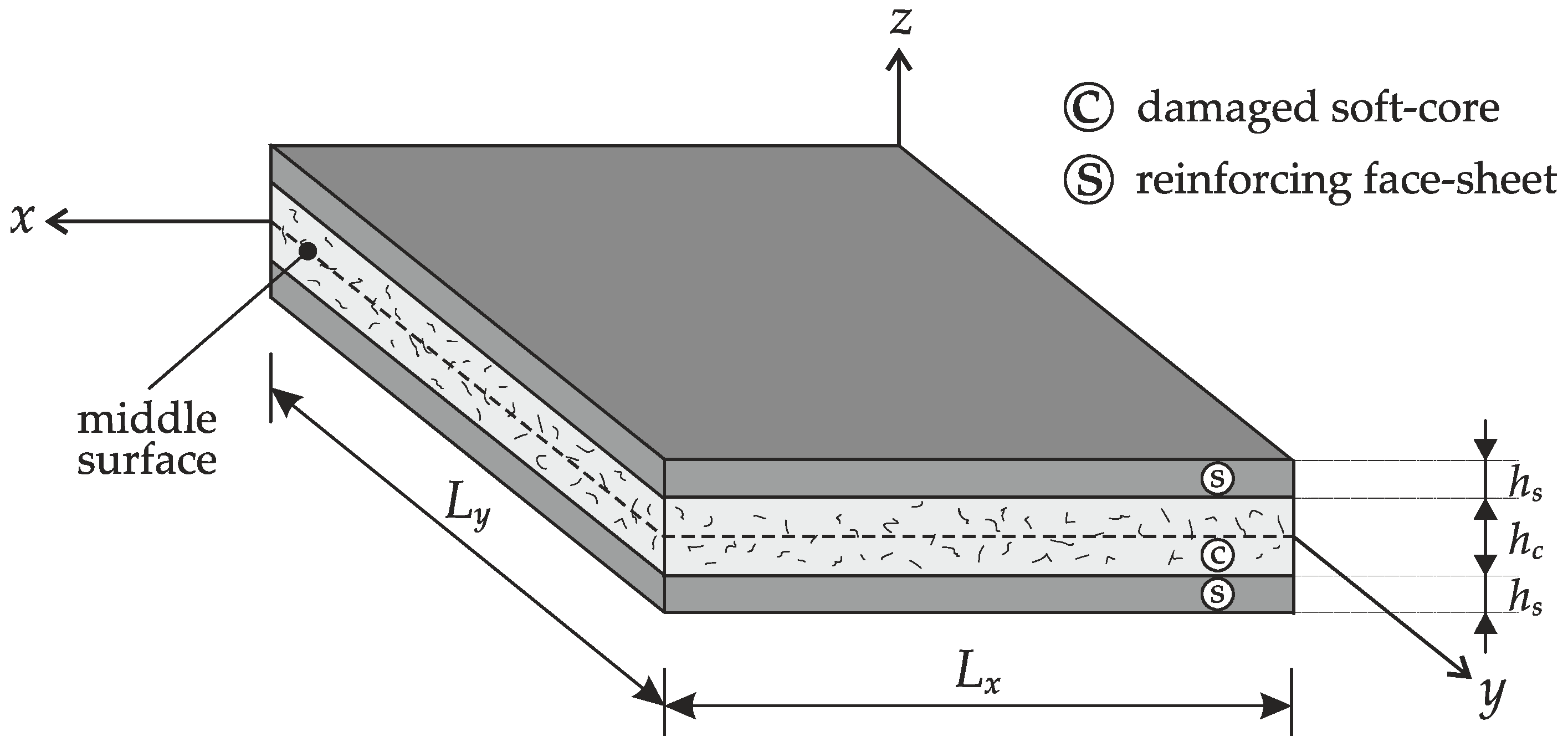
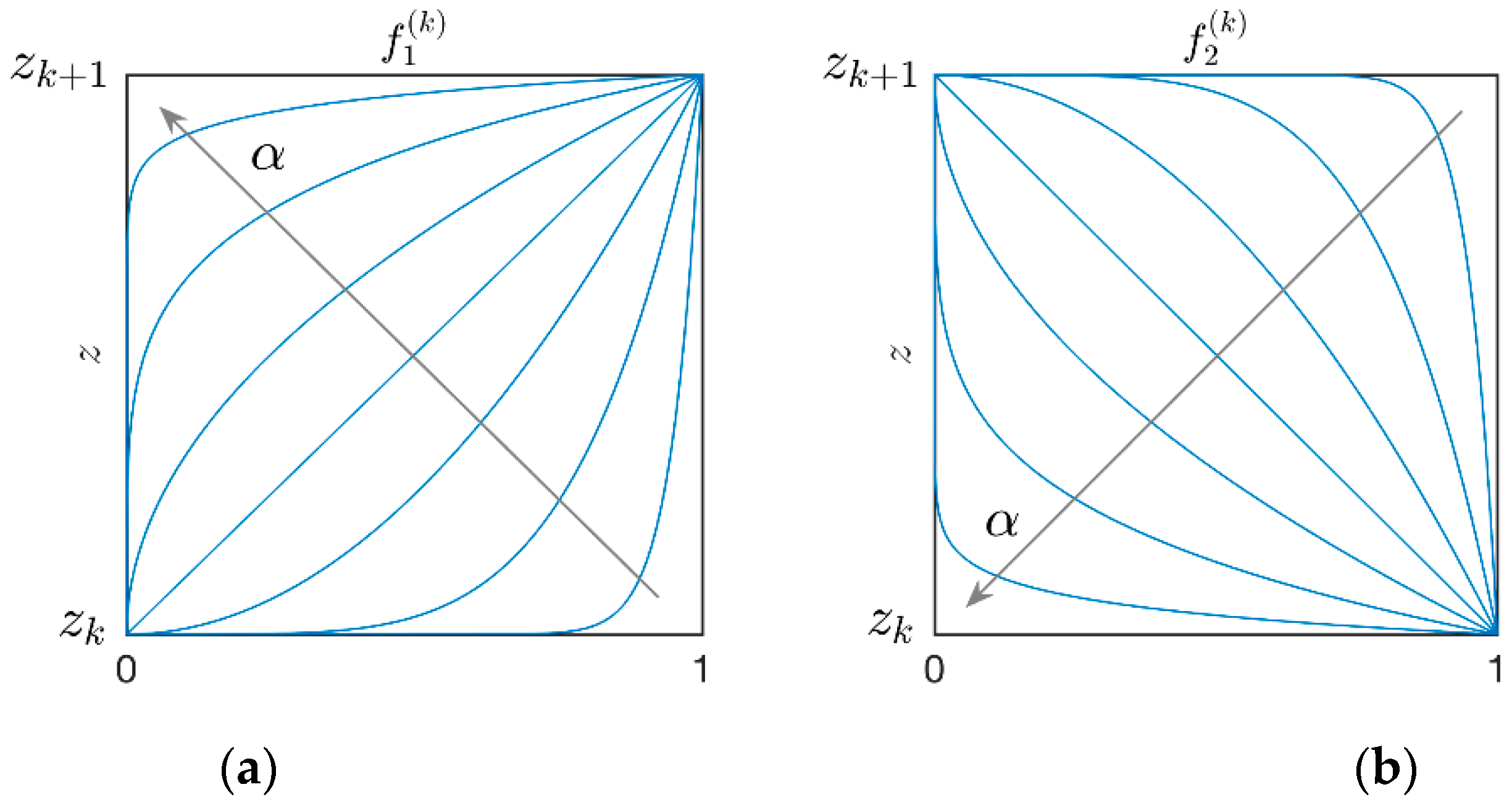
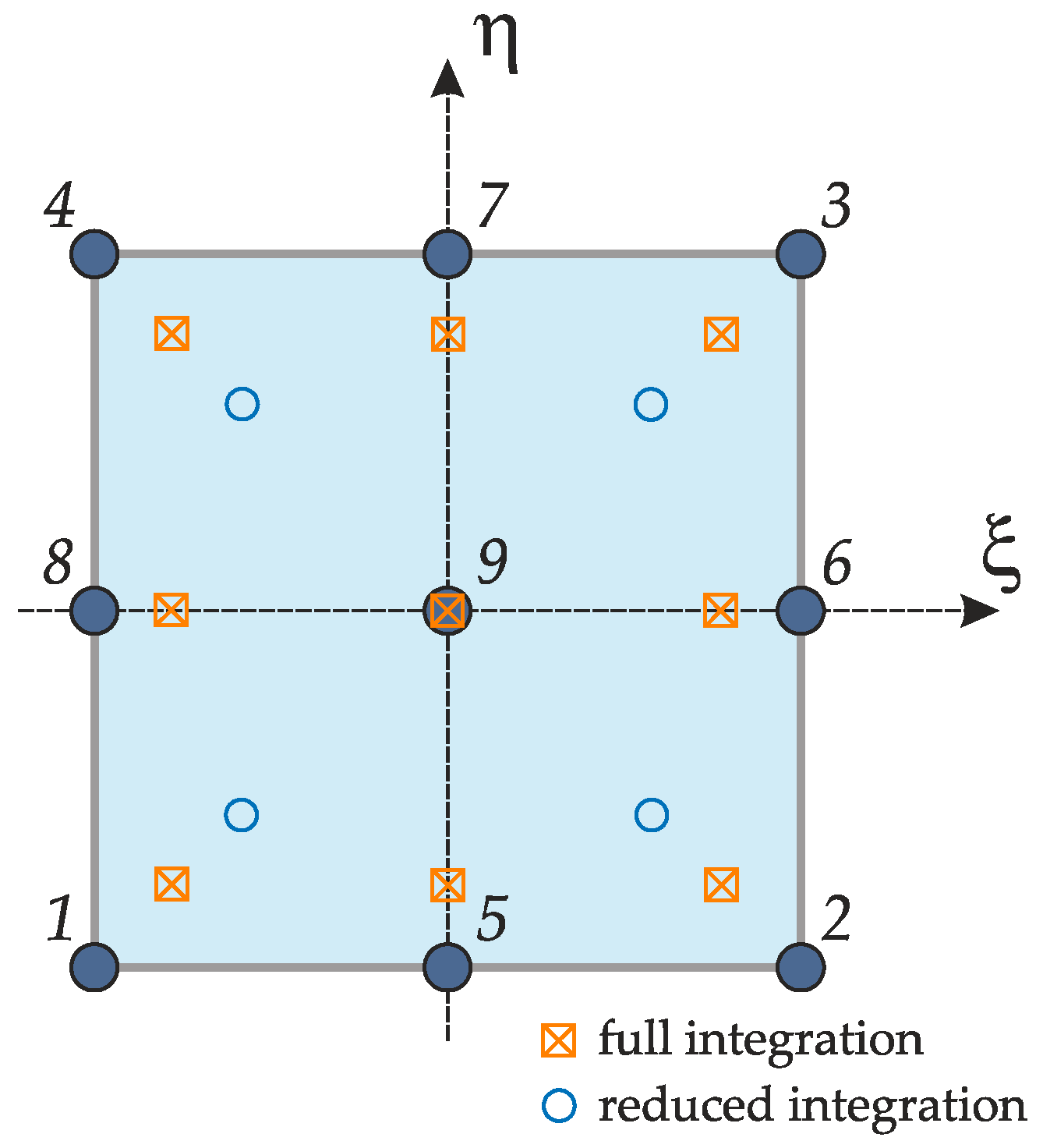

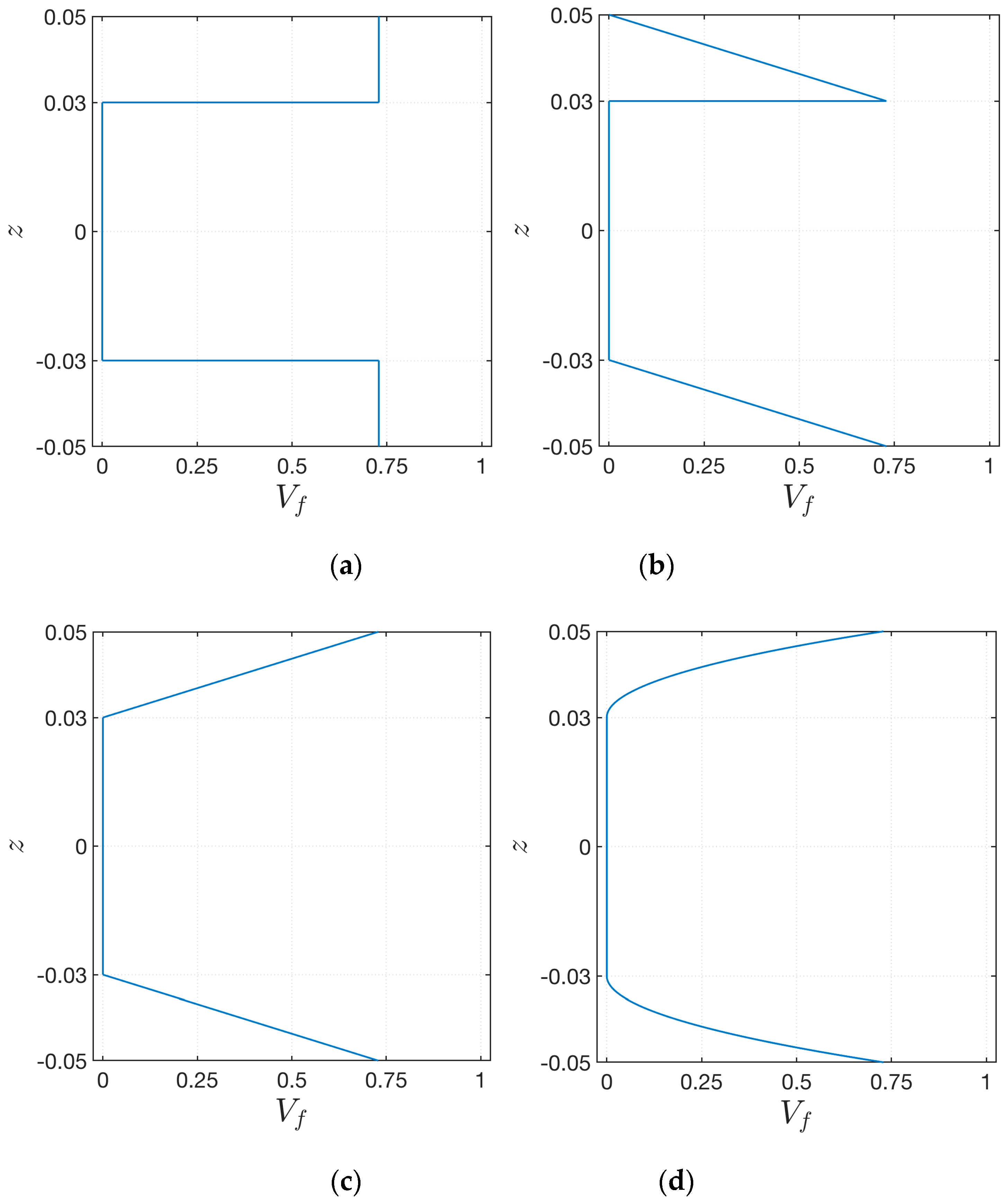

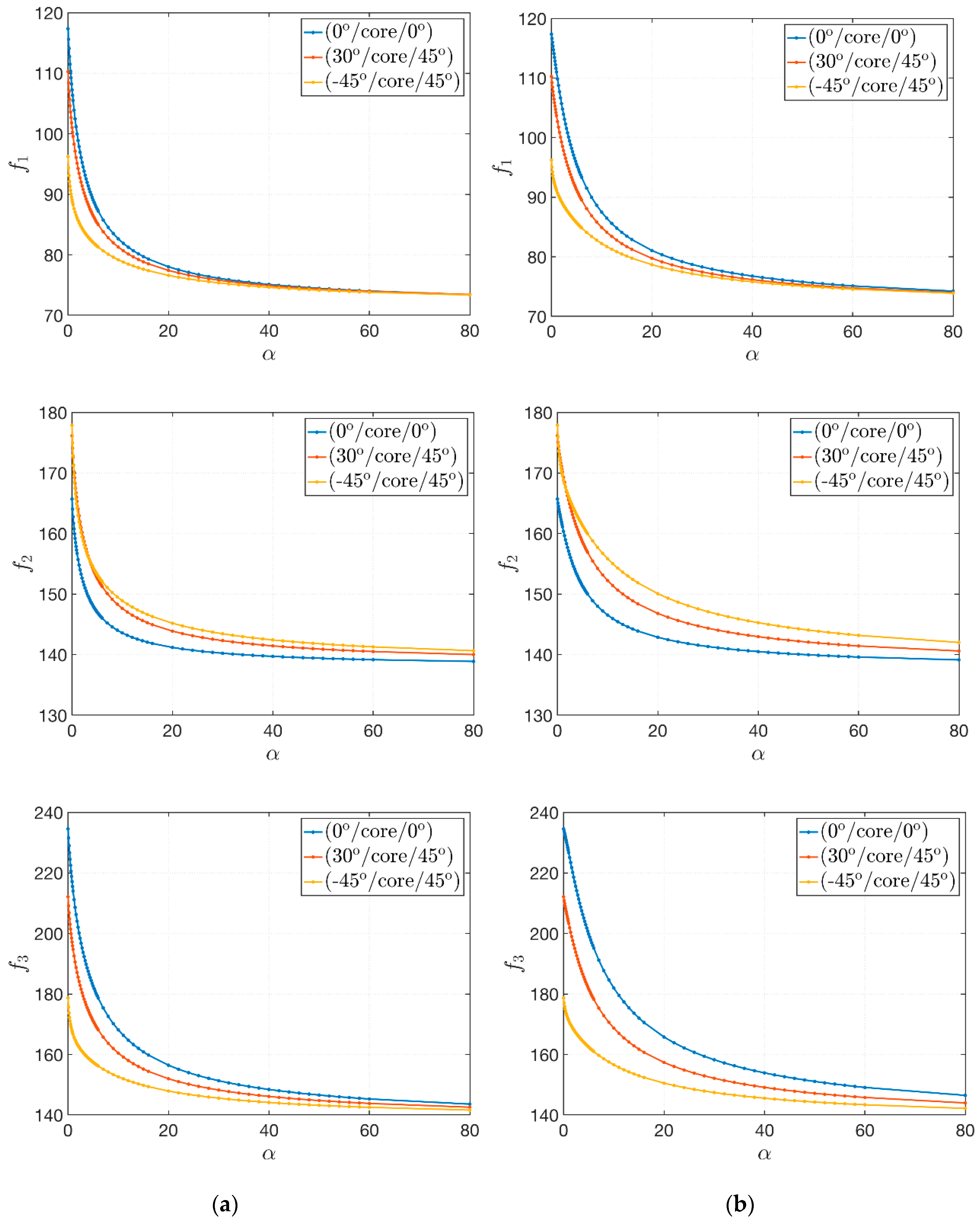
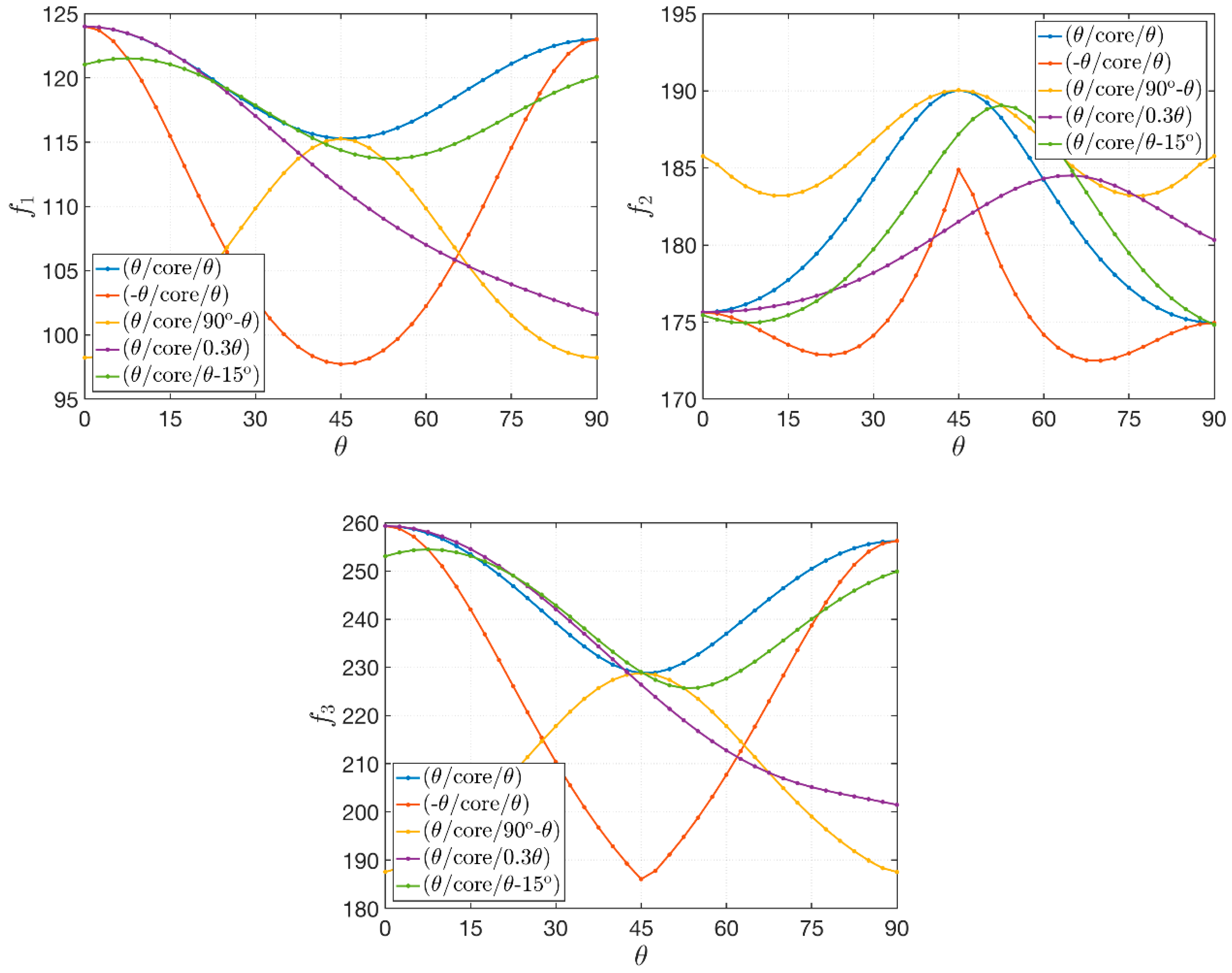
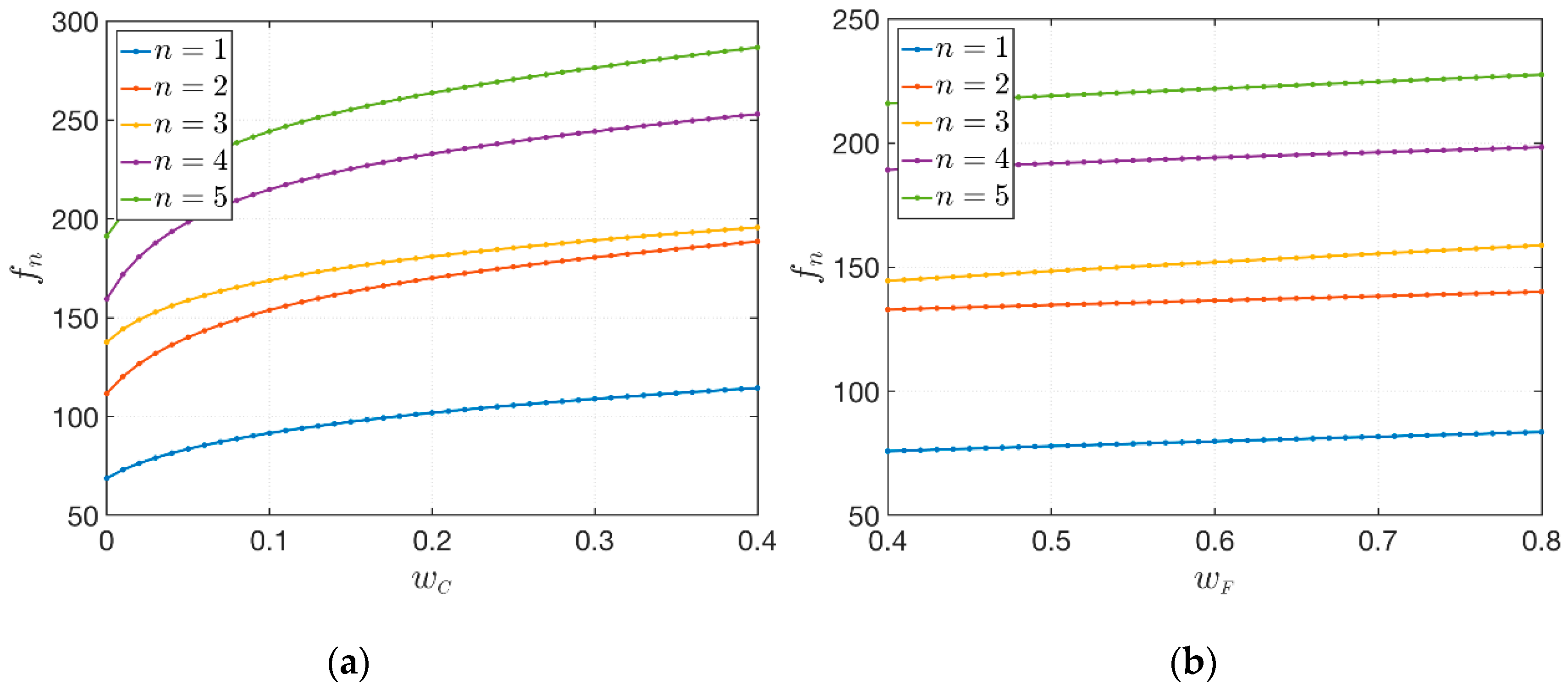

| Hill’s Elastic Moduli | Density |
|---|---|
| Constituent | Young’s Moduli | Shear Moduli | Poisson’s Ratios | Density |
|---|---|---|---|---|
| Carbon fibers | ||||
| Epoxy resin | − |
| Mode | 3D-FE | RMZ | RM | %diff (RMZ) | %diff (RM) |
|---|---|---|---|---|---|
| Lamination scheme: (0°/core/0°) | |||||
| 1 | 142.126 | 137.126 | 169.127 | 3.52% | 19.00% |
| 2 | 195.625 | 189.516 | 224.819 | 3.12% | 14.92% |
| 3 | 289.303 | 280.546 | 324.708 | 3.03% | 12.24% |
| 4 | 303.824 | 288.429 | 408.390 | 5.07% | 34.42% |
| 5 | 346.073 | 329.618 | 453.375 | 4.75% | 31.01% |
| 6 | 414.415 | 401.529 | 463.476 | 3.11% | 11.84% |
| 7 | 421.211 | 402.429 | 533.774 | 4.46% | 26.72% |
| 8 | 498.657 | 469.706 | 635.351 | 5.81% | 27.41% |
| 9 | 527.513 | 504.420 | 650.839 | 4.38% | 23.38% |
| 10 | 534.573 | 505.028 | 678.379 | 5.53% | 26.90% |
| Lamination scheme: (30°/core/45°) | |||||
| 1 | 129.776 | 125.889 | 147.134 | 2.99% | 13.38% |
| 2 | 211.140 | 203.739 | 244.133 | 3.51% | 15.63% |
| 3 | 265.283 | 253.703 | 327.302 | 4.37% | 23.38% |
| 4 | 299.738 | 288.099 | 354.309 | 3.88% | 18.21% |
| 5 | 371.903 | 354.527 | 462.224 | 4.67% | 24.29% |
| 6 | 398.033 | 381.561 | 476.960 | 4.14% | 19.83% |
| 7 | 426.714 | 404.619 | 562.840 | 5.18% | 31.90% |
| 8 | 483.191 | 459.287 | 616.601 | 4.95% | 27.61% |
| 9 | 506.505 | 484.458 | 616.724 | 4.35% | 21.76% |
| 10 | 541.210 | 512.228 | 704.809 | 5.36% | 30.23% |
| Lamination scheme: (−45°/core/45°) | |||||
| 1 | 107.180 | 105.297 | 112.930 | 1.76% | 5.36% |
| 2 | 206.687 | 201.053 | 225.234 | 2.73% | 8.97% |
| 3 | 206.687 | 201.516 | 225.234 | 2.50% | 8.97% |
| 4 | 290.914 | 281.838 | 322.709 | 3.12% | 10.93% |
| 5 | 346.351 | 334.314 | 392.846 | 3.48% | 13.42% |
| 6 | 348.741 | 337.043 | 395.240 | 3.35% | 13.33% |
| 7 | 419.280 | 403.125 | 479.272 | 3.85% | 14.31% |
| 8 | 419.280 | 404.002 | 479.272 | 3.64% | 14.31% |
| 9 | 515.903 | 494.071 | 608.811 | 4.23% | 18.01% |
| 10 | 515.903 | 496.715 | 608.811 | 3.72% | 18.01% |
| Mode | Lei et al. [71] (kp-Ritz) | Lei et al. [71] (Commercial FE) | RMZ (MIX) | RMZ (HT) |
|---|---|---|---|---|
| Case 1 | ||||
| 1 | 16.667 | 16.707 | 16.671 | 17.383 |
| 2 | 22.138 | 22.253 | 22.098 | 23.381 |
| 3 | 32.237 | 32.378 | 32.211 | 33.630 |
| 4 | 32.424 | 32.857 | 32.242 | 34.397 |
| 5 | 35.674 | 35.809 | 35.652 | 37.437 |
| 6 | 37.367 | 37.447 | 37.403 | 40.615 |
| Case 2 | ||||
| 1 | 18.045 | 18.083 | 18.055 | 19.071 |
| 2 | 23.498 | 23.606 | 23.448 | 25.152 |
| 3 | 33.915 | 34.338 | 33.712 | 36.116 |
| 4 | 34.361 | 34.467 | 34.324 | 36.449 |
| 5 | 37.367 | 37.447 | 37.403 | 39.892 |
| 6 | 37.693 | 37.786 | 37.637 | 40.616 |
| Case | Stacking Sequence | Damage | Exponent |
|---|---|---|---|
| 1 | (0°/core/0°) | 0.00 | 1 |
| 2 | (0°/core/0°) | 0.50 | 1 |
| 3 | (0°/core/0°) | 0.50 | 12 |
| 4 | (30°/core/45°) | 0.00 | 1 |
| 5 | (30°/core/45°) | 0.50 | 1 |
| 6 | (30°/core/45°) | 0.50 | 4 |
| 7 | (30°/core/45°) | 0.50 | 12 |
© 2019 by the authors. Licensee MDPI, Basel, Switzerland. This article is an open access article distributed under the terms and conditions of the Creative Commons Attribution (CC BY) license (http://creativecommons.org/licenses/by/4.0/).
Share and Cite
Bacciocchi, M.; Luciano, R.; Majorana, C.; Tarantino, A.M. Free Vibrations of Sandwich Plates with Damaged Soft-Core and Non-Uniform Mechanical Properties: Modeling and Finite Element Analysis. Materials 2019, 12, 2444. https://doi.org/10.3390/ma12152444
Bacciocchi M, Luciano R, Majorana C, Tarantino AM. Free Vibrations of Sandwich Plates with Damaged Soft-Core and Non-Uniform Mechanical Properties: Modeling and Finite Element Analysis. Materials. 2019; 12(15):2444. https://doi.org/10.3390/ma12152444
Chicago/Turabian StyleBacciocchi, Michele, Raimondo Luciano, Carmelo Majorana, and Angelo Marcello Tarantino. 2019. "Free Vibrations of Sandwich Plates with Damaged Soft-Core and Non-Uniform Mechanical Properties: Modeling and Finite Element Analysis" Materials 12, no. 15: 2444. https://doi.org/10.3390/ma12152444





